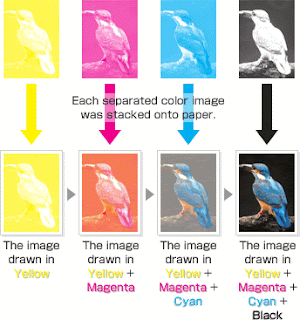DEFINITION OF COLOUR SEPARATIONS
http://www.google.co.uk/search?hl=en&client=firefox-a&hs=Pco&rls=org.mozilla:en-US:official&biw=1280&bih=635&q=colour+separation&tbs=dfn:1&tbo=u&sa=X&ei=VSutTqSzHcWY8QO6oem5Cw&ved=0CB8QkQ4
Web definitions
- Color printing or Colour printing is the reproduction of an image or text in color (as opposed to simpler black and white or monochrome printing). ...
- (Colour separations) The process of preparing artwork, for printing by separating into the four primary printing colours, CMYK.
- (Colour separations) the division of a multi-coloured original or line copy into the basic (or primary) process colours of yellow, magenta, cyan and black. These should not be confused with the optical primaries, red, green and blue.
- (COLOUR SEPARATIONS) are the 4 pieces of film negatives used in the production of making the photomechanical printing plates (See above)
- (Colour separations) Originals which have been separated to identify spot colour differences within the specifications i.e. one original with spot colour headings only, the other with the body of text only
Definition: Color separation is the process by which
original artwork is separated into individual color components for
printing. The components are cyan, magenta, yellow and black, known as CMYK.
By combining these colors, a wide spectrum of colors can be produced on
the printed page. In this four color printing process, each color is
applied to a printing plate. When the colors are combined on paper (they
are actually printed as small dots), the human eye combines the colors
to see the final image. The use of plates for printing is part of the
process known as lithography.
Also Known As: Four-color Process
Common Misspellings: Color Seperation
The act of decomposing a color graphic or photo into
single-color layers. For example, to print full-color photos with an offset printing press, one must first separate the photo into the four basic ink colors: cyan, magenta, yellow, and black (CMYK). Each single-color layer is then printed separately, one on top of the other, to give the impression of infinite colors.
This type of color separation, mixing three or four colors to produce an infinite variety of colors, is called process color separation. Another type of color separation, called spot color separation, is used to separate colors that are not to be mixed. In this case, each spot color is represented by its own ink, which is specially mixed. Spot colors are effective for highlighting text but they cannot be used to reproduce full-color images.
Traditionally, process color separation has been performed photographically with different colored filters. However, many modern desktop publishing systems are now capable of producing color separations for graphics stored electronically. This capability is essential if you want to create full-color documents on your computer and then print them using an offset printer. You don't need to perform color separation if you are printing directly to a color printer because in this case the printer itself performs the color separation internally.
This type of color separation, mixing three or four colors to produce an infinite variety of colors, is called process color separation. Another type of color separation, called spot color separation, is used to separate colors that are not to be mixed. In this case, each spot color is represented by its own ink, which is specially mixed. Spot colors are effective for highlighting text but they cannot be used to reproduce full-color images.
Traditionally, process color separation has been performed photographically with different colored filters. However, many modern desktop publishing systems are now capable of producing color separations for graphics stored electronically. This capability is essential if you want to create full-color documents on your computer and then print them using an offset printer. You don't need to perform color separation if you are printing directly to a color printer because in this case the printer itself performs the color separation internally.
Color separation process
The process of color separation starts by separating the original artwork into red, green, and blue components (for example by a digital scanner). Before digital imaging was developed, the traditional method of doing this was to photograph the image three times, using a filter for each color. However this is achieved, the desired result is three grayscale images, which represent the red, green, and blue (RGB) components of the original image:The next step is to invert each of these separations. When a negative image of the red component is produced, the resulting image represents the cyan component of the image. Likewise, negatives are produced of the green and blue components to produce magenta and yellow separations, respectively. This is done because cyan, magenta, and yellow are subtractive primaries which each represent two of the three additive primaries (RGB) after one additive primary has been subtracted from white light.
Cyan, magenta, and yellow are the three basic colors used for color reproduction. When these three colors are variously used in printing the result should be a reasonable reproduction of the original, but in practice this is not the case. Due to limitations in the inks, the darker colors are dirty and muddied. To resolve this, a black separation is also created, which improves the shadow and contrast of the image. Numerous techniques exist to derive this black separation from the original image; these include grey component replacement, under color removal, and under color addition. This printing technique is referred to as CMYK (the "K" being short for "key." In this case, the key color is black).
Today's digital printing methods do not have the restriction of a single color space that traditional CMYK processes do. Many presses can print from files that were ripped with images using either RGB or CMYK modes. The color reproduction abilities of a particular color space can vary; the process of obtaining accurate colors within a color model is called color matching.
IMAGES OF COLOUR SEPARATIONS
http://www.fujixerox.com/eng/company/technology/mechanism/images/top/process2_illust.gif
http://www.fujixerox.com/eng/company/technology/mechanism/images/top/process3_illust.gif





No comments:
Post a Comment